
In the River KATSURA --Vol.96--

When rhododendrons came into flower, I used to go to the refreshing mountain stream in mountainous districts.
A Trophy Size Yamame Trout and an Old Rainbow Trout
I caught a brown trout so easily in the River Katsura, whose existence I had not been sure of. The fish was caught when it was still light, actually at too early hour in comparison with the River Oshino. Now I cast the fly just at the lower reaches of the barrier. Since the surface reflected the light, I could not see through the bottom but knew that there was an attractive deep spot.
Muddler Sedge pulled by the leader drifted to the right and to the left. It looked like a real insect at a distance. Then the second cast. The fly disappeared into the water with a sound of gurgle. I set the hook to the fish. Immediately I felt the pull as heavy as the first fish’s. I guessed that it was a brown trout from its pull when it went down to the bottom without running downstream.

Lunn’s Particular was a standard fly for yamame trout fishing in August, 1975.
Scrubbing
If I find a new habitat of brown trout only with a few casting, it will be called a great discovery! I stood on the protected bank, full of hope. But soon I found something strange. What an odd pull! I felt something uncomfortable. It was what I felt when the line was snagged and my feeling became stronger. Finally the line stopped moving. I tried everything, tightened or loosened it, or swung the rod little by little, with no success. There seemed to be no other way than walking into the water to remove the snagged line.Anyway, I wanted to see the fish even though it was not particularly big. I decided to walk into the water. But it was a tough work because both banks were completely protected around there. At least there was no way down. Looking around, I found a series of footholds on the opposite bank. I crossed the bridge at the lower reaches with the rod in my hand. Fortunately the backing line in the reel was long enough. I managed to go around to the opposite bank.
I climbed down to the river along the iron steps built in the protected bank, winding the reel to avoid loosing the line. I walked in the shallow current a little. Then I reached a line of the stream where I thought that my line was snagged. Unfortunately the place was such a deep channel that I could not walk into it. However, there was a big rock above it and I clung to the rock to look around.
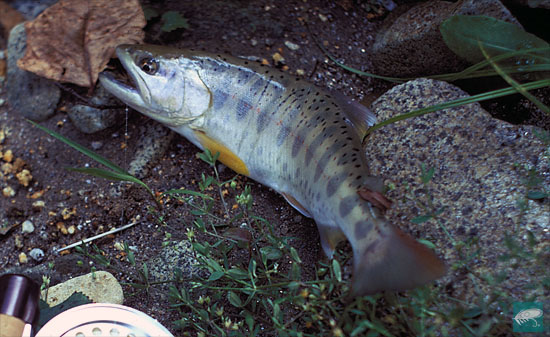
Apricot Spinner made in September, 1975, was clearly seen even in the shade.
Soon I knew what caused snagging. The rock I clung to and the rocks in the deep channel, all rocks were lumps of concrete and some iron bars were exposed here and there. They were the waste of the barrier construction. Withered reeds were entangled there. Once the line was stuck there, it never removed. I gave up and pulled the line. The line was easily broken. Probably there was no fish at the other end of the line. Too bad! The only comfort was that the fish was not so big.
I put a new leader to the line and Muddler Sedge to the leader tip. It was getting rather dark. There was no time left to fish a large area. I thought that big fish were staying at the pool on the right bank at the upper reaches of the bridge. Standing at the upper reaches of it, I cast the fly.
The pool was deep enough but looked like a deep current rather than a deep pool. Every spot seemed to be a fast current in comparison with the River Oshino. Even though I took that into account, the stream was so rapid that I worried that there would be no evening rise. It was already the time of evening rise but there was no sign as far as I could see. The flowing sound of the water incessantly echoed between the protected banks. Unlike quiet Oshino, the sound will not be heard unless the fish make rise so powerfully, so I thought.
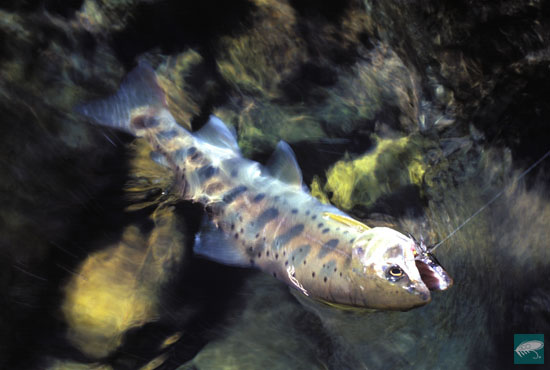
I cast Muddler Sedge to the opposite bank. Rapid stream and changeable surface made it cross the stream so soon that I could not follow how it moved. I stood on the protected bank. I cast the fly 5 or 6 times, changing the line length little by little, until the fly covered the whole area of not so large pool.
I tried to see through the water at the lower reaches of the bridge or looked back to see around the spot where I had walked into the river but there was no remarkable change. When I half gave up, the rod was suddenly snatched. The fly had been drifting so long. As soon as I raised the rod I felt a sharp strong pull. The fish ran to the right and to the left in the fast current. It was different from a brown trout. What is it?
After fighting for a while, the fish calmed down and I knew that it was not so big. It kept pulling the line with vibrations but I never felt its weight. I waited for good timing carefully. As soon as it broke the surface, I lifted it on the protected bank. An olive body in good shape appeared in the twilight. A yamame trout! I had expected it to be a bigger one, judging from its strong pull but it was a little bit over 30cm.
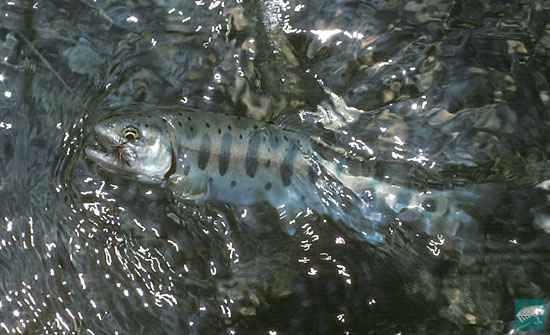
A Brown Bullet
Later on the River Katsura returned to its former stream and big rainbow trout I aimed at never appeared for some period. I still caught a lot of yamame trout. Their sizes were about 25cm in the daytime and over 30cm in the evening, but not over 35cm. Strangely enough, there was no shadow of brown trout. The brown trout which had bitten my first Muddler Sedge miraculously survived in the River Katsura? In mid-May there was no catch in the upper reaches in the daytime. Anyway, the season of mountain streams started in the mountainous area and my fishing switched from the River Katsura to those streams.2 years later, one day in March, 1975, I took my regular fishing course, that is, in the River Katsura in the daytime and then in the River Oshino in the evening. It was a mild sunny day without wind. Yamame trout made rises here and there from the morning. After I enjoyed fishing with various patterns of spinners, I put Muddler Sedge to the line, praying that my dream would come true again. I moved to the lower reaches of the barrier. Probably because of the flood in the previous year, the left bank where I had caught the brown trout was buried and the right bank had a deep spot. I crossed the bridge and aimed at the pocket of the right bank. I had caught a large number of fish around there for those 2 years but none of them was bigger than that brown trout.
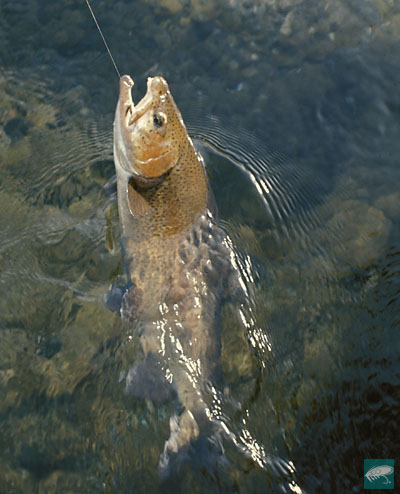
In March, 1975, a rainbow trout, which distracted my attention from the River Katsura for the next 10 years, broke the surface with Muddler Sedge in its mouth.
Foams made by the pocket stretched downstream along the line of the stream. When Muddler Sedge crawled on the surface, crossing the line, a huge column of water stood with the sound of explosion. As soon as I raised the rod, the reel screamed and a brown lump broke the surface. The fish moved to the opposite bank and soon turned around to run downstream. I nearly froze for a moment. If the fish passes under the bridge to go farther downstream, I will be able to do nothing. Fortunately the fish stopped before the bridge, turned around to go upstream and slid into the pocket.
My fighting with the fish turned into an endurance contest. The fish repeatedly rose from the bottom a little and went down. It was more than 5 minutes later that it broke the surface sideways. My arms were paralyzed. The fish became calm with its large mouth open.
It was a red-brown male rainbow trout of 50cm. Its fins were bigger and its body thinner than one in Oshino. It looked half as heavy as one in Oshino. Its appearance told that it was not so young. Probably harsh circumstance of the River Katsura does not allow rainbow trout to be fat or big even when they live long. I thought so in those days. I knew later how my idea missed the point! Although some years later I caught a lot of big rainbow trout in the River Katsura, I never saw such a thin old one. Shockingly, my first rainbow trout was far from the typical one of the River Katsura! If that fish had been a standard one, my fishing research would have been progressed a lot. Instead, that fish made me give up the River Katsura and consider it as a river to kill time before I went to the River Oshino, farther upstream, for the next ten years. That means I seldom enjoyed evening rises in the River Katsura.
-- To be continued --
- NET SHOP INFORMATION
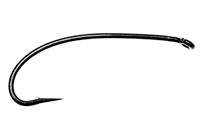
SL6 Black Spey Hooks
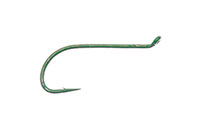
DU3 Limerick Spinner Hooks
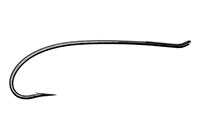
SL4 Single Bartleet Hooks
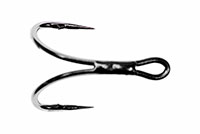
XD1 Tube Fly Double Hooks
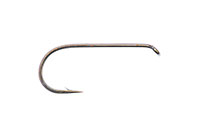
DD2 Flat Perfect Hooks
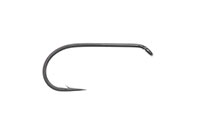
DD1 Black Terrestrial Hooks
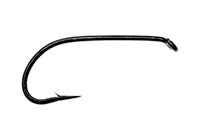
TD4 Old Limerick Wet Hooks
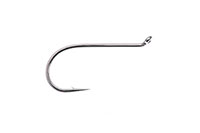
DU1 Silver May Hooks
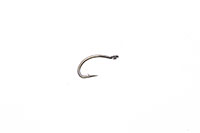
MU1 Flat Midge Hooks
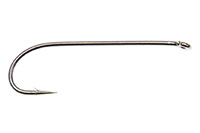
LD3 Long Limerick Hooks
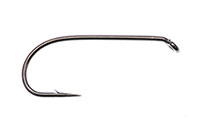
TD2 Summer Sproat Hooks
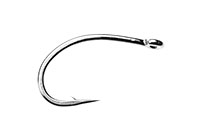
XS1 Tube Single Silver Hooks
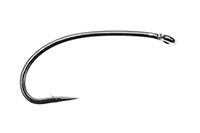
TD6 Siver Sedge Hooks

SL5 Black Spey Hooks

DU3 Limerick Spinner Hooks
- TROPHY CLUB
- FLY SHOW
- EXHIBITION
- MASTERS`
- FLY DRESSING CONTEST Archives
- TRAVELLER Archives
- TACKLE IMPRESSIONS Archives
- ANGLERS` PHOTO GALLERY Archives
- ----------------------------------------------
- トロフィークラブ
- フライショー
- エキシビション
- マスターズ
- フライドレッシング・コンテスト・アーカイヴ
- トラヴェラー・アーカイヴ
- タックル・インプレッション・アーカイヴ
- アングラーズ・フォトギャラリー・アーカイヴ
株式会社サワダ 185-0021 東京都国分寺市南町3-13-4
SAWADA'S INC. 3-13-4 Minamicho, Kokubunji, Tokyo 185-0021, Japan
写真・ドキュメントの無断転載を禁じます。
All the images and documents found on this site are owned by Ken Sawada and may not be used without permission.
But, link to this site is FREE.
Copyright © 2000 - 2024 SAWADA'S INC.. All rights reserved.
SAWADA'S INC. 3-13-4 Minamicho, Kokubunji, Tokyo 185-0021, Japan
写真・ドキュメントの無断転載を禁じます。
All the images and documents found on this site are owned by Ken Sawada and may not be used without permission.
But, link to this site is FREE.
Copyright © 2000 - 2024 SAWADA'S INC.. All rights reserved.
